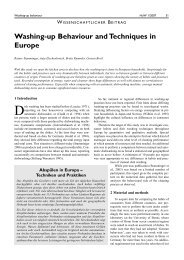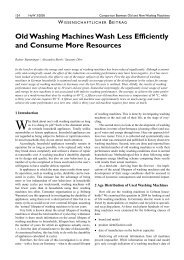Development of a novel mechatronic system for mechanical weed ...
Development of a novel mechatronic system for mechanical weed ...
Development of a novel mechatronic system for mechanical weed ...
Create successful ePaper yourself
Turn your PDF publications into a flip-book with our unique Google optimized e-Paper software.
4.1.2 Data acquisition<br />
4.1.2.1 Hardware<br />
Materials and methods<br />
After conditioning, signals from sensors are acquired with a notebook PC<br />
computer through a plug and play multifunctional USB DAQPad-6015 from<br />
National Instruments. The combination <strong>of</strong> DAQPad-6015 and signal<br />
conditioning unit is designed <strong>for</strong> a broad range <strong>of</strong> measurements in the field.<br />
The DAQPad-6015 consists <strong>of</strong> sixteen 16-bit analog input channels, two analog<br />
output channels and eight digital input/output channels and two counters. The<br />
<strong>system</strong> is user friendly, including NI-DAQmx measurement services s<strong>of</strong>tware <strong>for</strong><br />
simple applications and it is compatible with NI LabVIEW, LabWindows/CVI,<br />
Measurement Studio <strong>for</strong> Visual Studio .NET and other USB data acquisition<br />
devices. The maximum sampling rate <strong>of</strong> the device is up to 200,000 samples/s<br />
<strong>for</strong> a single channel.<br />
4.1.2.2 S<strong>of</strong>tware<br />
The s<strong>of</strong>tware solution <strong>for</strong> the data acquisition and plant position detection was<br />
realised with LabVIEW 8 from National Instruments. LabVIEW is a plat<strong>for</strong>m and<br />
development environment <strong>for</strong> a visual programming language commonly used<br />
<strong>for</strong> data acquisition, instrument control, and industrial automation.<br />
The visual programming language used in LabVIEW is a dataflow language<br />
also known as G code or block diagram code. Execution is determined by the<br />
structure <strong>of</strong> a graphical block diagram, which is actually the source code. This<br />
language allows parallel execution on multi-processing and multi-threading<br />
hardware. Data flow completely defines the execution sequence and it is as<br />
well-defined as with any textually coded language such as C, Visual BASIC, etc.<br />
Programs and subroutines are called virtual instruments (VI-s). Each VI has<br />
three components: a block diagram, a front panel and a connector panel.<br />
LabVIEW includes a compiler that produces native code <strong>for</strong> the CPU plat<strong>for</strong>m.<br />
The graphical code is translated into executable machine code by interpreting<br />
the syntax and by compilation. The syntax is strictly en<strong>for</strong>ced during the editing<br />
39





